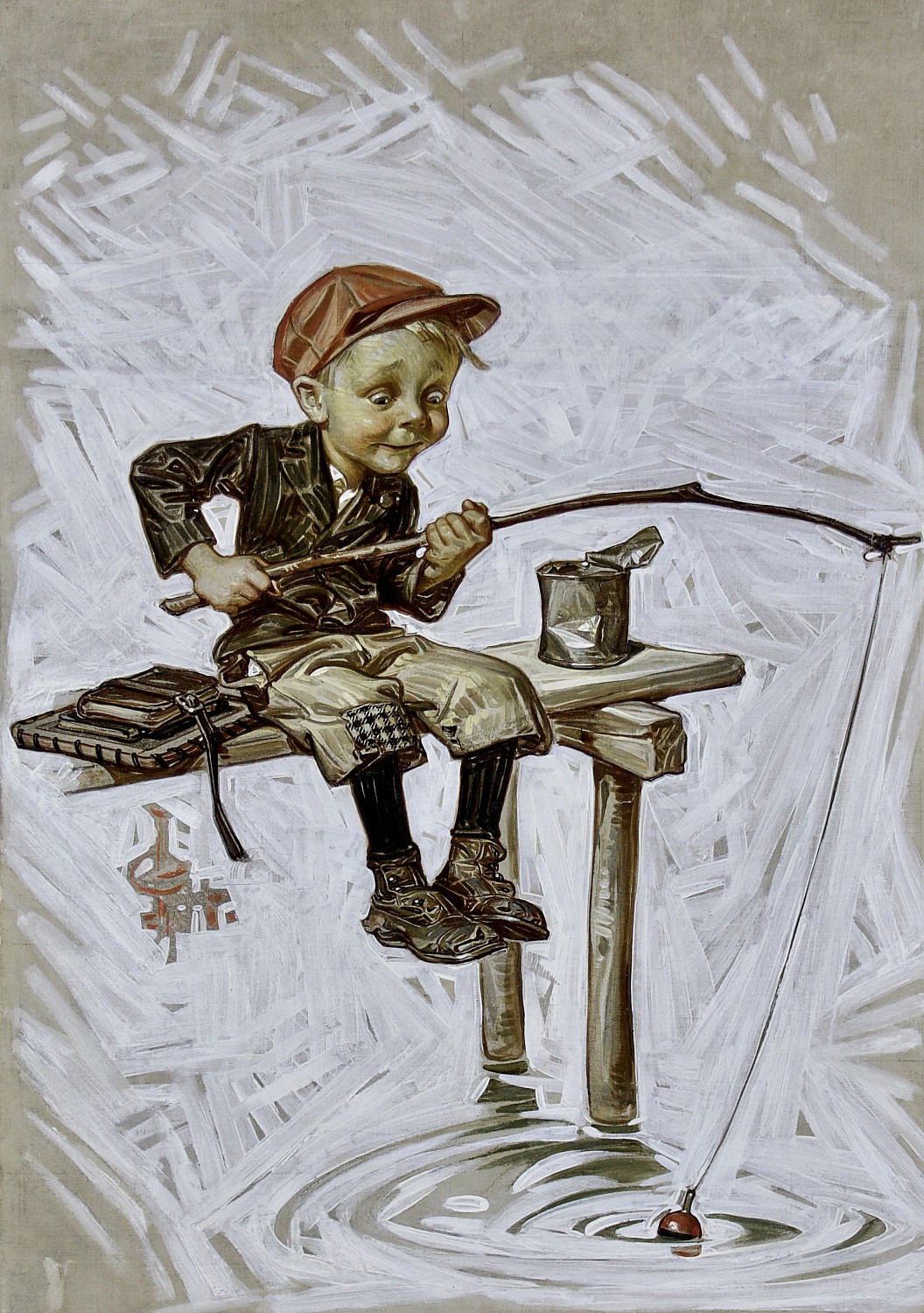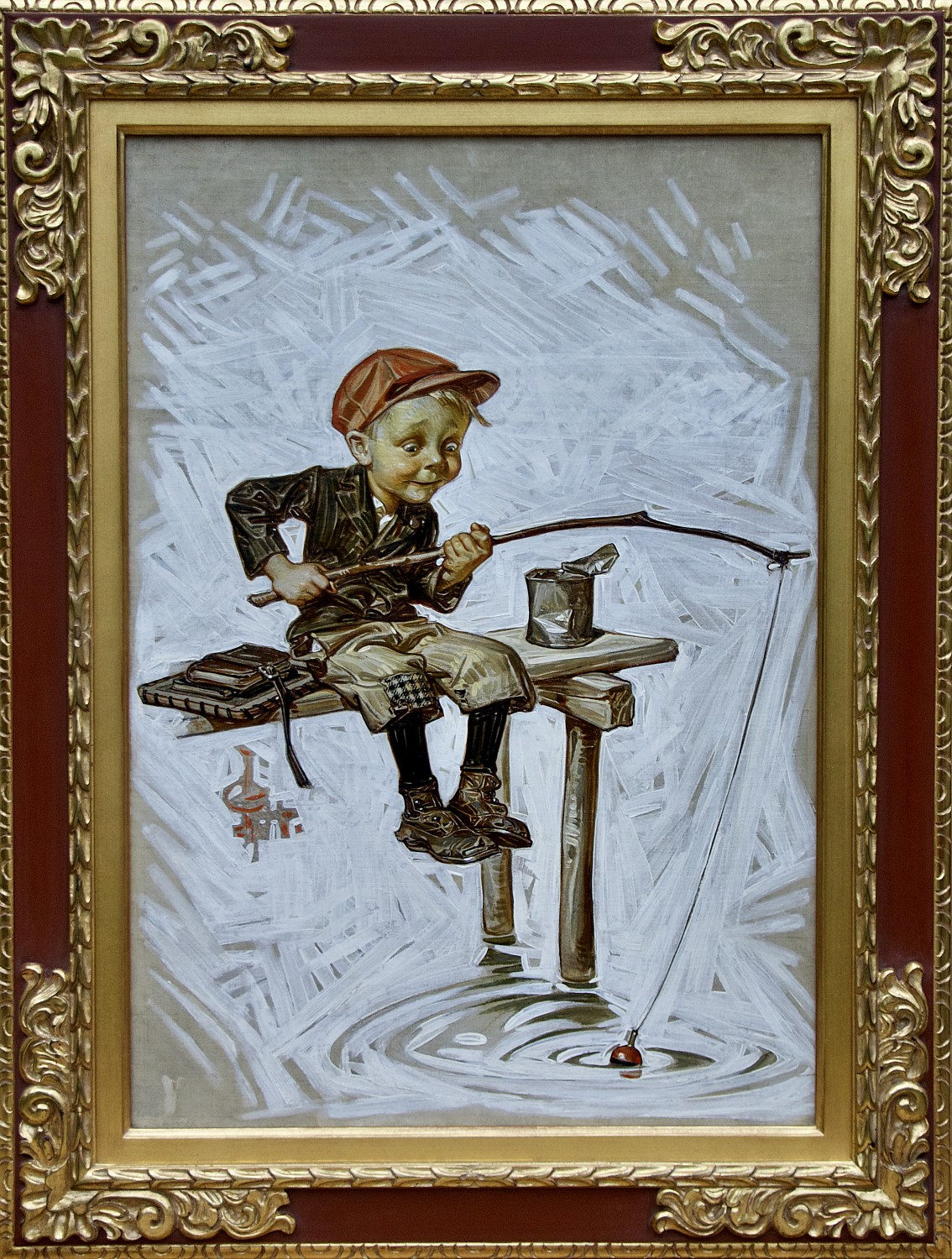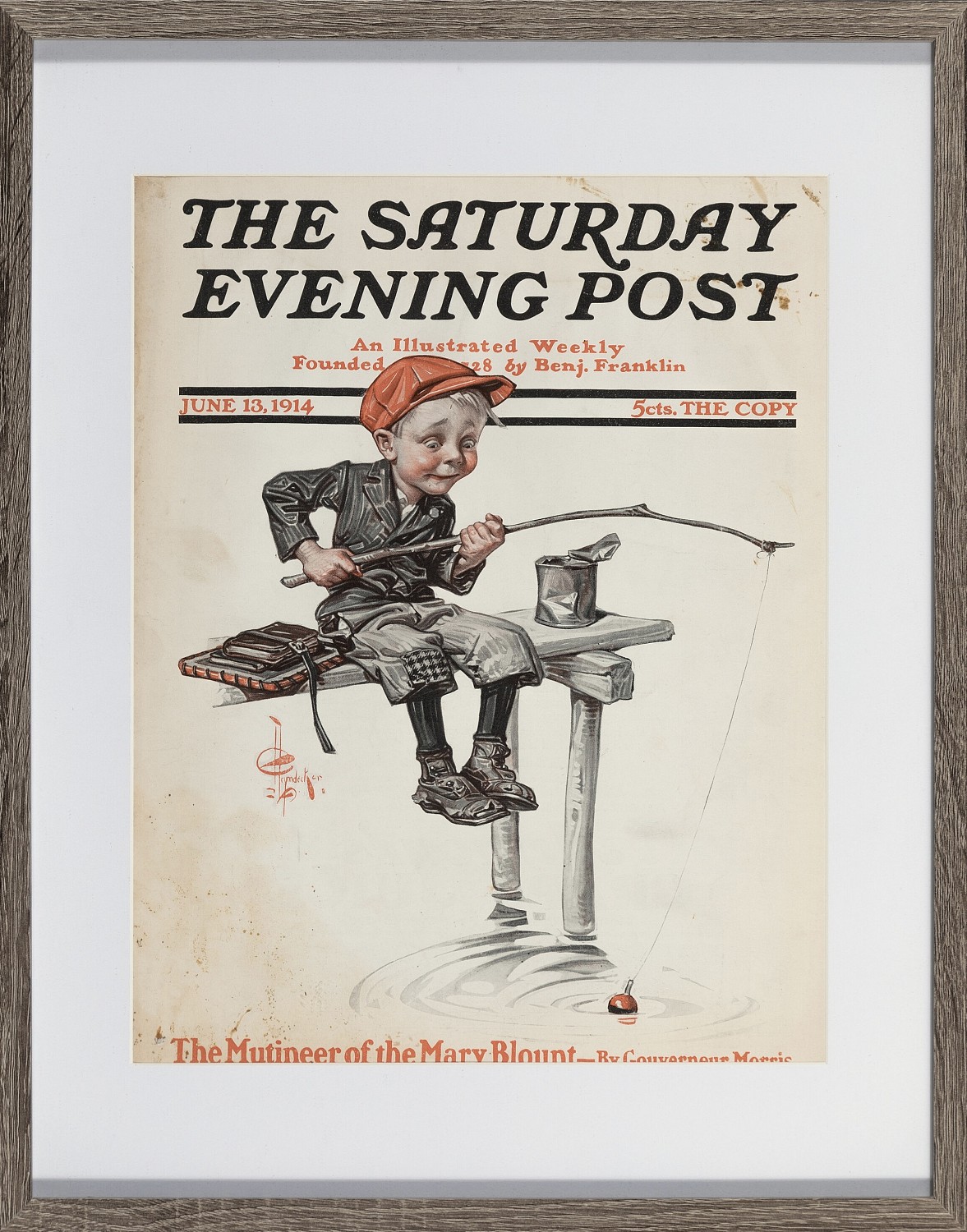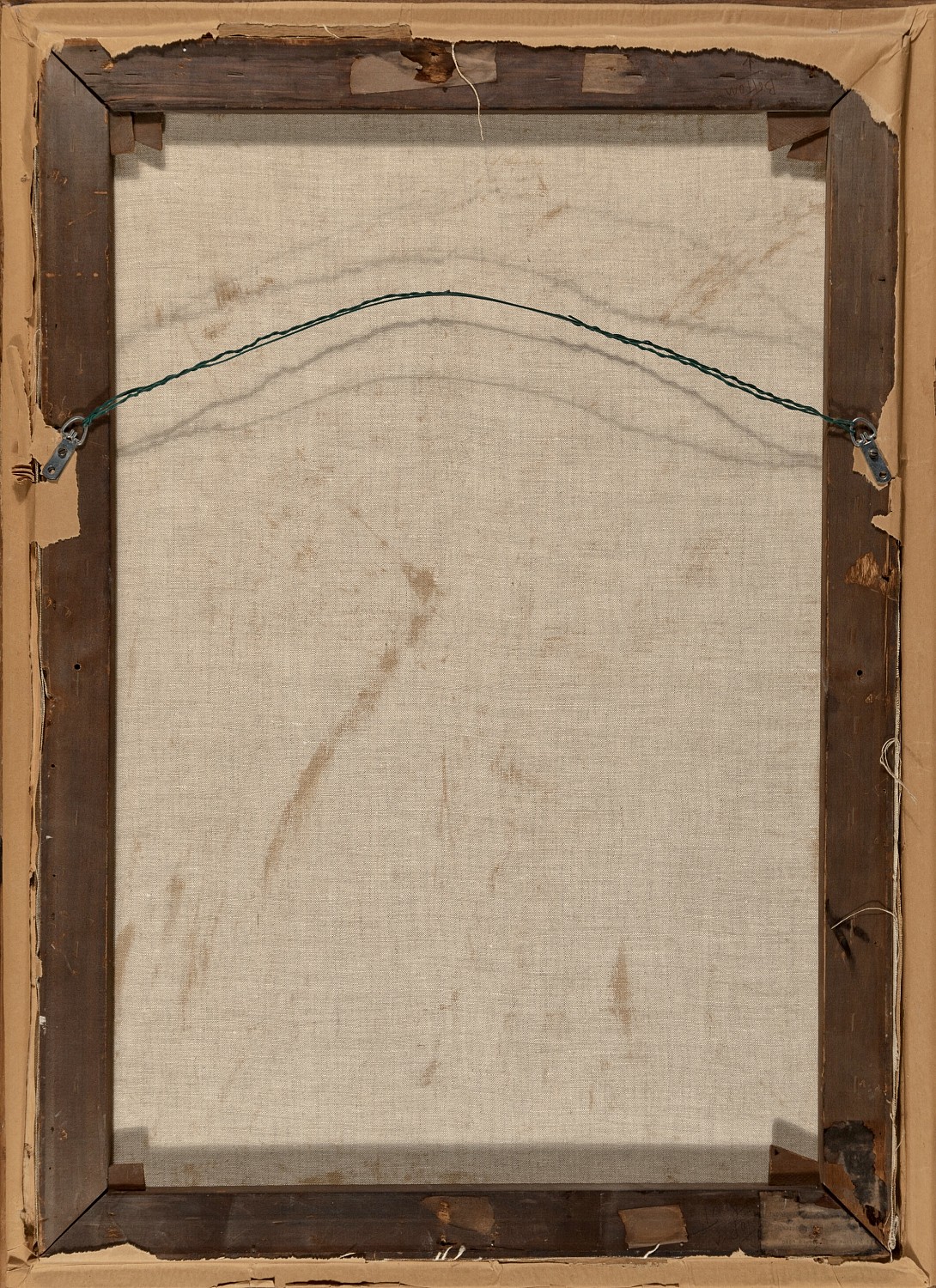"Playing Hooky, Post Cover" Lot no. 4568
By Joseph Christian Leyendecker (1874-1951)
1914
30.25" x 21"
Oil on canvas
Signed Lower Center
REQUEST PRICE
PURCHASE REQUEST
The Saturday Evening Post cover, June 13, 1914
LITERATURE:
L.S. Cutler and J.G. Cutler, J.C. Leyendecker, American Imagist, New York, 2008, p. 118, illustrated.
A gifted and inimitable draughtsman, Joseph Christian Leyendecker stands as a principal figure in the Golden Age of Illustration. As the inventor of the Arrow Collar Man, he defined dapper dressing and everyday activity for the entire prewar generation, and as the creator of more than 300 covers for The Saturday Evening Post, he revolutionized modern magazine design and chiefly informed Norman Rockwell's wistful vision of America.
A sensitive observer, Leyendecker also created poignant, whimsical works capturing the antics of children, as evidenced by his iconic, recurring New Year's Baby created exclusively for The Post. To many collector and historians, Leyendecker's scenes of children are some of the finest of his entire oeuvre. Playing Hooky of 1914 typifies Leyendecker's masterful ability to story--tell using a solitary figure as his subject-a precocious young boy enjoying some fishing time while cutting school--rendered in his distinctive staccato painting style.
By 1926, when The Saturday Evening Post went to four-color printing, which reproduced his paintings in all their creative and technical splendor, Leyendecker was the most famous illustrator in America. The artist understood not only how to paint, but also how to present a clear message to his audience at the newsstand in an instant. Of all the Golden Age Illustrators, Leyendecker perhaps understood best how much to include in his composition, but more importantly, he understood restraint, and how much to leave out, in order to get his message clearly across.
On the subject of magazine covers, Leyendecker told The Post:
"A cover is a poster; and more related to murals, even sculptures, than to illustration. It should, therefore, tell its story on one plane, be without realistic perspective and distance.... A cover that carries an explanatory legend defeats itself...The editor prefers the cover to the simple picture because the cover sells more copies of his magazine. It sells more copies because it carries further and hits harder. It hits harder because it is a symbol; it is concentrated and says what it has to say in a straight line. It carries further because a good cover has a distinct silhouette. The reader will notice it at a greater distance. And though he can't make out the design, still the design will pull him in." (as quoted in K. Steine and F.B. Taraba, The J.C. Leyendecker Collection: American Illustrators Poster Book, Portland, Oregon, 1995, p. 12)
In the present work a darling young boy, blonde hair tousled and pantleg patched, sits on a dock with his schoolbooks abandoned beside him, excitedly waiting for a catch. His glee is unmistakable, knowing that his parents are none the wiser to his skipping-school-escapade. Positioned up close on the picture plane, one cannot help but notice the spectacular rendering of various textures evident in the painting, from the crop of blonde hair to the creased jacket and pants, to the smooth shiny surface of the beat up can holding his bait. The simple yet effective scene is skillfully rendered in rich reds, browns, and yellows, applied with Leyendecker's hallmark cross-hatching technique. The result is a highly refined, wonderfully descriptive snapshot of a moment that every person who misbehaved in childhood can appreciate.
Playing Hooky was painted in 1914, the same year as 'Beat-up Boy, Football Hero' which established a new auction record for artist when it sold for a staggering $4,121,250 at Heritage Auctions in May 2021. it is likely that the same boy served as a model for this work. Additionally, the present work has a similarly interesting history: The consignor's father, while helping clean out the artist's home following his death, saved the work from destruction in 1951 when Leyendecker's sister was destroying his works and selling his art for a pittance in New Rochelle, New York.
Explore related art collections: Saturday Evening Post Covers / Magazine Covers / $100,000 & Above
See all original artwork by Joseph Christian Leyendecker
ABOUT THE ARTIST
Joseph Christian Leyendecker was born in Montabaur, Germany, and came to America at the age of eight. Showing an early interest in painting, he got his first job at 16 in a Chicago engraving house on the strength of some larger pictures he had painted on kitchen oilcloth. In the evenings after work, he studied under Vanderpoel at the Chicago Art Institute, and saved for five years to be able to go to France and attend the Academie Julian in Paris.
Upon his return, as a thoroughly trained artist with immense technical facility, Leyendecker had no difficulty in obtaining top commissions for advertising illustrations and cover designs for the leading publications. His first Post cover was done in 1899, and he did well over 300 more during the next 40 years. Among the most famous of these was his annual New Years Baby series.
His advertising illustrations made his clients famous. The Arrow Collar Man was a byword for the debonair, handsome male, and women wrote thousands of love letters to him in care of Cluett Peabody & Company. His illustrations for Kuppenheimer Clothes were equally successful in promoting an image of suited elegance. He was elected to the Society of Illustrators Hall of Fame in 1977.A major retrospective exhibition of Leyendecker's work was mounted at the Norman Rockwell Museum in Stockbridge, Massachusetts, in 1997-98.
Joseph Christian Leyendecker was born in Montabaur, Germany, and came to America at the age of eight. Showing an early interest in painting, he got his first job at 16 in a Chicago engraving house on the strength of some larger pictures he had painted on kitchen oilcloth. In the evenings after work, he studied under Vanderpoel at the Chicago Art Institute, and saved for five years to be able to go to France and attend the Academie Julian in Paris.
Upon his return, as a thoroughly trained artist with immense technical facility, Leyendecker had no difficulty in obtaining top commissions for advertising illustrations and cover designs for the leading publications. His first Post cover was done in 1899, and he did well over 300 more during the next 40 years. Among the most famous of these was his annual New Years Baby series.
His advertising illustrations made his clients famous. The Arrow Collar Man was a byword for the debonair, handsome male, and women wrote thousands of love letters to him in care of Cluett Peabody & Company. His illustrations for Kuppenheimer Clothes were equally successful in promoting an image of suited elegance. He was elected to the Society of Illustrators Hall of Fame in 1977.A major retrospective exhibition of Leyendecker's work was mounted at the Norman Rockwell Museum in Stockbridge, Massachusetts, in 1997-98.
Kent Steine







